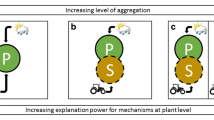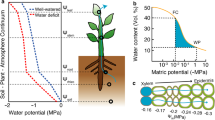Abstract
Maize seedlings were grown for 10 to 20 days in either nutrient solution or in soils with or without fertilizer supply. Air temperature was kept uniform for all treatments, while root zone temperature (RZT) was varied between 12 and 24°C. In some treatments the basal part of the shoot (with apical shoot meristem and zone of leaf elongation) was lifted up to separate the indirect effects of root zone temperature on shoot growth from the direct effects of temperature on the shoot meristem.
Shoot and root growth were decreased by low RZT to a similar extent irrespective of the growth medium (i.e. nutrient solution, fertilized or unfertilized soil). In all culture media Ca concentration was similar or even higher in plants grown at 12 as compared to 24°. At lower RZT concentrations of N, P and K in the shoot dry matter decreased in unfertilized soil, whereas in nutrient solution and fertilized soil only the K concentration decreased.
When direct temperature effects on the shoot meristem were reduced by lifting the basal part of the shoot above the temperature-controlled root zone, shoot growth at low RZT was significantly increased in nutrient solution and fertilized soil, but not in unfertilized soil. In fertilized soil and nutrient solution at low RZT the uptake of K increased to a similar extent as plant growth, and thus shoot K concentration was not reduced by increasing shoot growth rates. In contrast, uptake of N and P was not increased, resulting in significantly decreased shoot concentrations.
It is concluded that shoot growth at suboptimal RZT was limited both by a direct temperature effect on shoot activity and by a reduced nutrient supply through the roots. Nutrient concentrations in the shoot tissue at low RZT were not only influenced by availability in the substrate and dilution by growth, but also by the internal demand for growth.
Similar content being viewed by others
References
AdamsF, BurmesterC, HueN V and LongF L 1980 Comparison of column-displacement and centrifuge methods for obtaining soil solution. Soil Sci. Soc. Am. J. 44, 733–735.
AtkinR K, BartonG E and RobinsonD K 1973 Effect of root growing temperature on growth substances in xylem exudate of Zea mays. J. Exp. Bot. 24, 475–487.
BarlowE W R and BoersmaL 1976 Interaction between leaf elongation, photosynthesis, and carbohydrate levels of water-stressed corn seedlings. Agron. J. 68, 923–926.
BarlowE W R, BoersmaL and YoungJ L 1976 Root temperature and soil water potential effects on growth and soluble carbohydrate concentration of corn seedlings. Crop Sci. 16, 59–62.
BeauchampE G and TorranceJ K 1969 Temperature gradients within young maize plant stalks as influenced by aerial and root zone temperatures. Plant and Soil 30, 241–251.
BravoF P and UribeE G 1981 Temperature dependence of the concentration kinetics of absorption of phosphate and potassium in corn roots. Plant Physiol. 67, 815–819.
BrouwerR 1983 Functional equilibrium: Sense or nonsense. Neth. J. Agric. Sci. 31, 335–348.
ChingP C and BarberS A 1979 Evaluation of temperature effects on K-uptake by corn. Agron. J. 71, 1040–1044.
GerickeS and KurmiesB 1952 Die colorimetrische Phosphorsäurebestimmung mit Ammonium-Vanadat-Molybdat und ihre Anwendung in der Pflanzenanlyse. Z. Pflanzenernaehr. Dueng. Bodenkd. 59, 235–247.
GrobbelaarW P 1963 Responses of young maize plants to root temperatures. Med. van de Landbouw Hogeschool te Wageningen Nederl. 63, 1–71.
JungkA and ClaassenN 1989 Availability in soil and acquisition by plants as the basis for phosphorus and potassium supply to plants. Z. Pflanzenernaehr. Bodenkd. 152, 151–157.
KleinendorstA 1975 An explosion of leaf growth after stress conditions. Neth. J. Agric. Sci. 23, 139–144.
KleinendorstA and BroawerR 1970 The effect of temperature of the root medium and the growing point of the shoot on growth, water content, and sugar content of maize leaves. Neth. J. Agric. Sci. 18, 140–148.
KnollH A, BradyN C and Lathwell 1964 Effect of soil temperature and phosphorus fertilization on the growth and phosphorus content of corn. Agron. J. 56, 145–147.
KnollH A, LathwellD J and BradyN L 1964 The influence of root zone temperature on the growth and contents of phosphorus and anthocyan of corn. Soil Sci. Soc. Am. Proc. 28, 400–403.
LeighR A and Wyn JonesR G 1984 A hypothesis relating critical potassium concentrations for growth to the distribution and function of this ion in the plant cell. New Phytol. 97, 1–13.
MackayA D and BarberS A 1984 Soil temperature effects on root growth and phosphorus uptake by corn. Soil Sci. Soc. Am. J. 48, 813–823.
PattersonR P, GrunesP L and LathwellD J 1972 Influence of rootzone temperature and P supply on total and inorganic P, free sugars, aconitate and soluble amino N in corn. Crop Sci. 12, 227–230.
SasakiY, OkuboA, MurakamiT, ArimaY and KumazawaK 1987 Radial transport of phosphate in corn roots (II). J. Plant Nutr. 10, 1263–1271.
SetterT L and GreenwayH 1988 Growth reductions of rice at low root temperatures: Decreases in nutrient uptake and development of chlorosis. J. Exp. Bot. 39, 811–829.
SinghB B and JonesJ P 1977 Phosphorus sorption isotherm for evaluating phosphorus requirements of lettuce at five temperature regimes. Plant and Soil 46, 31–44.
SmithP G and DaleJ E 1988 The effects of root cooling and excision treatments on the growth of primary leaves of Phaseolus vulgaris L. Rapid and reversible increases in abscisic acid content. New Phytol. 110, 293–300.
Stamp P 1983 Root development of maize seedlings in dependence of genotype and temperature. In Proc. Int. Symp. Root Ecology and Its Practical Applications. Eds. W Böhm, L Kutschera and E Lichtenegger. pp 439–444. Verlag Gümpenstern, A-8952 Irding.
TennantD 1975 A test of a modifed and intersection method of estimating root length. J. Ecol. 63, 995–1001.
WalkerJ M 1969 One degree increments in soil temperatures affect maize seedling behaviour. Soil Sci. Soc. Am. Proc. 33, 729–736.
WattsW R 1972 Leaf extension in Zea mays, II. Leaf extension in response to independent variation of the temperature of the apical meristem, of the air around the leaves, and of the root zone. J. Exp. Bot. 23, 713–721.
Author information
Authors and Affiliations
Rights and permissions
About this article
Cite this article
Engels, C., Marschner, H. Effect of sub-optimal root zone temperatures at varied nutrient supply and shoot meristem temperature on growth and nutrient concentrations in maize seedlings (Zea mays L.). Plant Soil 126, 215–225 (1990). https://doi.org/10.1007/BF00012825
Received:
Issue Date:
DOI: https://doi.org/10.1007/BF00012825




